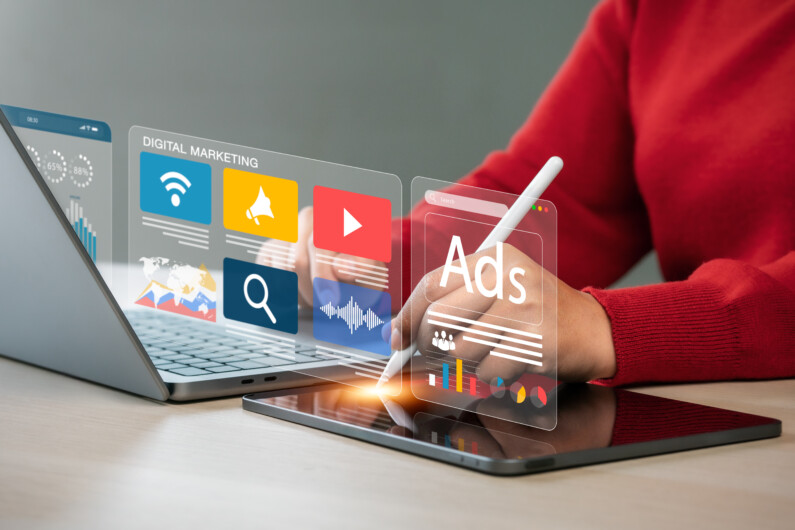Artificial intelligence (AI) is redefining the landscape of advertising campaigns, opening up unprecedented opportunities to combine creativity and precise targeting. In an environment where Google and Facebook are playing a role companies are faced with a major challenge: how to maximise the effectiveness of their campaigns while navigating a complex regulatory framework such as the RGPD ? Romain Rissoan, a specialist in the digital transition of businesses, takes a closer look.

AI for creative advertising
The integration of AI into advertising has marked a decisive turning point in the way advertising content is designed. Today, tools such as Meta AI Sandbox and Google Ads Creative Studio enable advertisers to generate highly personalised and engaging content in record time.
These tools useGenerative AI to create visual and text ads that immediately grab users' attention.
Examples
- Meta AI Sandbox offers dynamic backgrounds for images and optimised advertising texts
- Google Ads Creative Studio allows you to test and optimise ads in real time
These innovations make it easier to content preparation. They also frees up time for marketing teamswho can focus on more strategic aspects. For example: global campaign planning and creative innovation.
Examples of visual creation with AI
Heinz advertising campaign

Bescherelle advertising campaign

Example of video creation using AI
La laitière advertising campaign designed with an AI
The capabilities of these tools are based on the analysis of large quantities of data. This makes it possible to produce content that is not just aesthetically pleasing, but also relevant to the target audience. AI is able to analyse current market trends, user preferences and even past campaign performance to generate content that has a real impact.
[Training]
For professionals wishing to master these technologies and effectively integrate AI into their advertising strategies, the ORSYS Google Ads: optimising your campaigns in the age of artificial intelligence is an excellent starting point. It provides an in-depth understanding of how to use these tools to create effective and impactful advertising campaigns, maximising return on investment.
AI and advertising targeting
While AI is revolutionising advertising creation, it is also transforming audience targeting. The result: much more precise and effective campaigns. Traditionally, advertising campaigns were based on general market segments and basic demographic data. Today, thanks to AI, it is possible to target audiences with unprecedented precision.
Google Ads and Facebook use AI to refine targeting, analysing user behaviour, interests and even purchase intentions in real time. These platforms are capable of predicting consumer needs even before they are expressed, based on sophisticated predictive models. However, to maximise the effectiveness of these tools, companies need to go further by integrating their own data via Data Management Platforms (DMP) (or CDP Customer Data Platform). These platforms enable companies' internal data to be interconnected with advertising tools. This enriches user profiling and optimises campaigns.
Key figures
Source: Baromètre 2024 Ifop pour Talan "Les Français et les Generative AI "(April 2024)
Use of generative AI :
31 % of users use it to carry out searches.
29 % use them to save time.
46 % estimate an increase in productivity of more than 40 % thanks to AI.
Enterprise AI adoption:
48 % of users indicate that their company encourages the use of generative AI.
Benefits :
38 % of users appreciate the gains in productivity and efficiency.
80 % of users would recommend the use of AI to friends and family.
Integrating internal data allows you toimprove the relevance of advertisements by providing insights that Google or Facebook cannot obtain on their own.
Example
A company can use data from previous sales to target similar audiences or reactivate inactive customers. This not only increases the effectiveness of campaigns, but also maximises return on investment (ROI).
However, the collection and use of data must comply with the General Data Protection Regulation (GDPR), which poses new challenges for businesses. Understanding the legal implications and ensuring that data is processed ethically and securely is crucial. Transparency with users about how their data is used is becoming an absolute priority to avoid any violation of privacy rights.
[Training]
The ORSYS course Launching a digital advertising campaign is ideal for those wishing to deepen their knowledge of advanced targeting and the strategic use of DMP/CDP.
It covers the technical and legal aspects of data integration, offering a comprehensive approach to effective and compliant advertising campaigns.
Testimonial
Éric, digital marketing manager
"We've gone through several major phases in the implementation of artificial intelligence within our company. Firstly, the pure and simple creation of Google campaigns driven by personal data.
Then we gradually saw the emergence of the generative design proposed by Google, which meant that we didn't have to rely too heavily on our communications agency to create different advertising formats.
Last but not least, the arrival of ChatGPT has given us creativity and ideas to complement what our communications agency already provides.
The role of data in campaign optimisation
Data is the real fuel for AI in advertising campaigns. Not only does it make it possible to targeting the right audiencesbut alsoadjust campaigns in real time to maximise ROI. AI uses sophisticated algorithms to analyse massive volumes of data, identifying the best opportunities to deliver relevant ads at the right time.
The start of AI in conversion management came when Google began to offer campaigns with a target CPA (cost per acquisition). For example, you tell Google that you only want customers with a maximum spend of €10 per customer. Google then makes calculations to limit the number of high-cost, low-profit customers.
Of course, there is a downside. For one thing, Google has precious information about your business model. On the other hand, it generates a "monkey test" by Google, which then tries to give you back all the customers with a low acquisition cost. The risk? Bringing you customers of mediocre quality and depriving you of customers with higher added value.
Predictive analysis
AI plays a crucial role in thepredictive analysis. It enables companies to predict future consumer behaviour and adapt their campaigns accordingly.
For example, a company can use AI to anticipate periods of high demand and adjust its advertising budgets to maximise sales during these periods.
What's more, AI can automate large-scale A/B tests, enabling us to quickly determine which ad variants perform best.
However, data management in the context of the RGPD remains a major challenge. Companies must ensure that the data collected is anonymised and that its use is transparent to users. This also includes the need to obtain explicit consent from users for the use of their personal data. Compliance with these regulations is not only a legal obligation, but also a means of strengthening consumer confidence in the brand.
[Training]
To meet these challenges, ORSYS offers the following training courses Developing your communication strategy on Facebook.
This course covers best practice in using data strategically, while complying with current regulations, to ensure effective and ethical optimisation of advertising campaigns.
Participants will learn how to use Facebook's data analysis tools, create personalised audiences and measure the impact of their campaigns based on reliable and secure data.
What are the benefits for companies?
AI is already firmly established in current advertising practices. Companies around the world have integrated it into their advertising strategies with impressive results.
For example,Google Performance Max, Meta Advantage+ and TikTok Smart Performance Campaign are automated campaigns that use AI to optimise the delivery of ads across multiple channels, while maximising conversions. These tools not only save time, but also significantly increase the ROI of campaigns.
Google Performance Max uses AI to automatically determine the best combinations of advertising content and delivery channels, resulting in an average 13 % improvement in conversions for businesses that use it.
Meta Advantage+ can automatically test up to 150 content combinations, identifying the most effective variants to maximise results.
What are the results?
Feedback from companies that have used these technologies shows a significant improvement in performance, both in terms of targeting accuracy and reduced advertising costs. These success stories illustrate the potential of AI to transform not only the way campaigns are designed and executed, but also the way results are measured and optimised.
Ultimately, AI has become an essential tool for optimising advertising campaigns. By combining creativity, precise targeting and rigorous data management, it offers companies unprecedented opportunities. However, to take full advantage of these opportunities and remain competitive, it is essential to keep abreast of the latest technologies and practices, while bearing in mind the ethical and legal issues involved.





